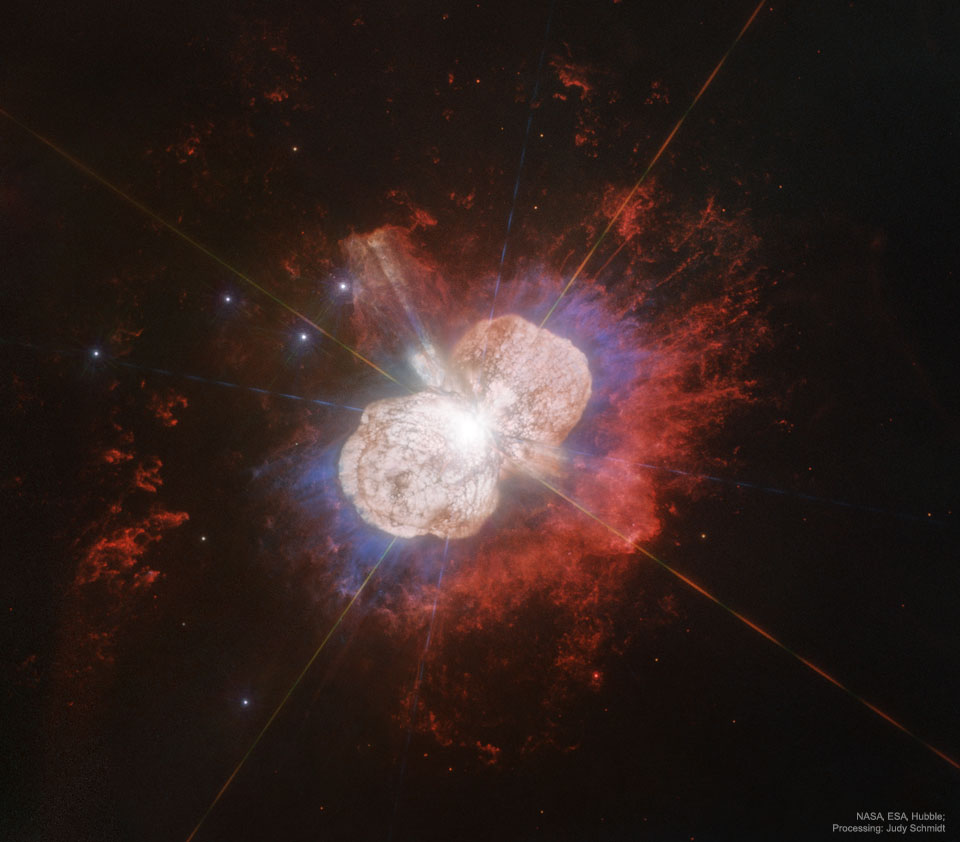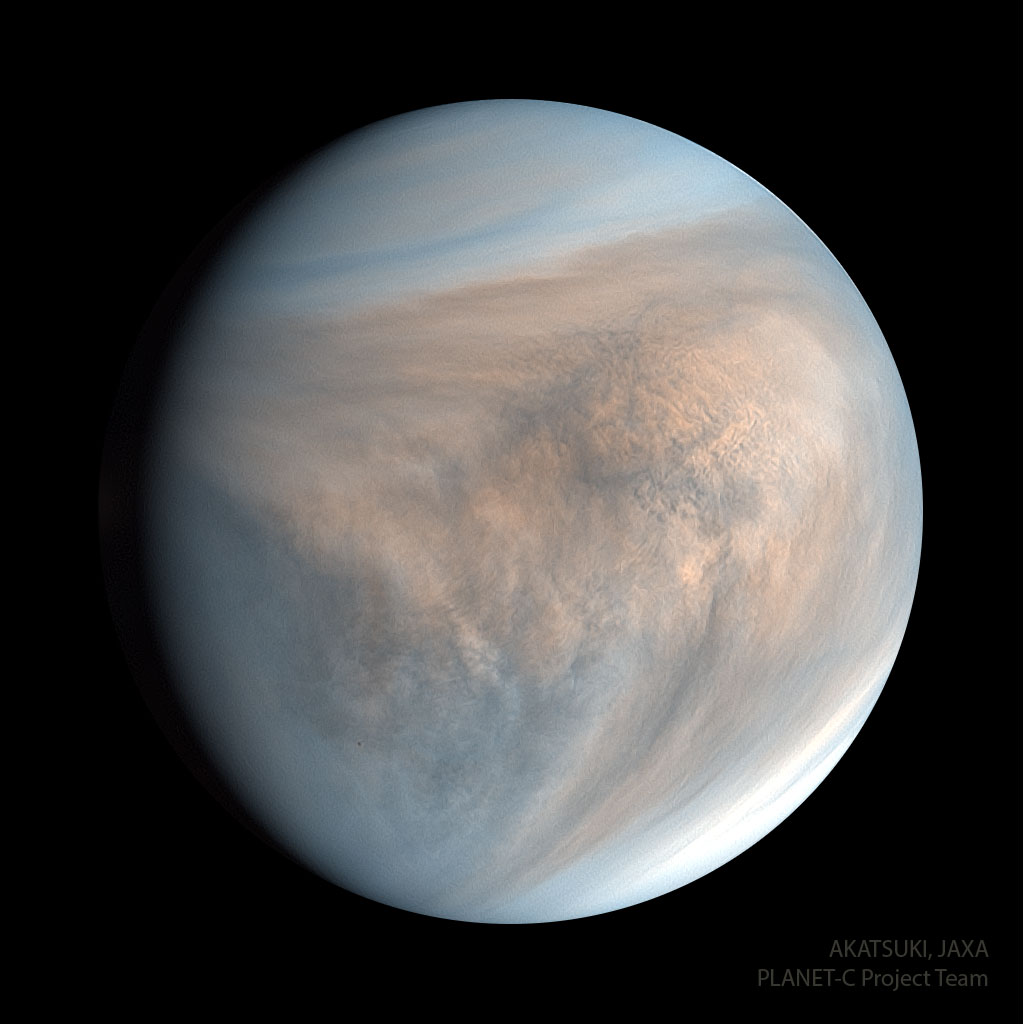Nombre total de pages vues
09/07/2023
METEOROLOGIE - Phénomène extraordinaire : le nuage en forme de champignon atomique
ASTRONOMY - Doomed Star Eta Carinae
2023 July 9
Image Credit & Copyright: NASA, ESA, Hubble; Processing & License: Judy Schmidt
Explanation: Eta Carinae may be about to explode. But no one knows when - it may be next year, it may be one million years from now. Eta Carinae's mass - about 100 times greater than our Sun - makes it an excellent candidate for a full blown supernova. Historical records do show that about 170 years ago Eta Carinae underwent an unusual outburst that made it one of the brightest stars in the southern sky. Eta Carinae, in the Keyhole Nebula, is the only star currently thought to emit natural LASER light. This featured image brings out details in the unusual nebula that surrounds this rogue star. Diffraction spikes, caused by the telescope, are visible as bright multi-colored streaks emanating from Eta Carinae's center. Two distinct lobes of the Homunculus Nebula encompass the hot central region, while some strange radial streaks are visible in red extending toward the image right. The lobes are filled with lanes of gas and dust which absorb the blue and ultraviolet light emitted near the center. The streaks, however, remain unexplained.
06/07/2023
ASTRONOMY - Fireworks vs Supermoon
2023 July 6
Image Credit & Copyright: Michael Seeley
Explanation: On July 4, an almost Full Moon rose in planet Earth's evening skies. Also known as a Buck Moon, the full lunar phase (full on July 3 at 11:39 UTC) was near perigee, the closest point in the Moon's almost monthly orbit around planet Earth. That qualified this July's Full Moon as a supermoon, the first of four supermoons in 2023. Seen from Cocoa Beach along Florida's Space Coast on July 4, any big, bright, beautiful Full Moon would still have to compete for attention though. July's super-moonrise was captured here against a super-colorful fireworks display.
PHOTOGRAPHIE - Le monde explosif d'Alan Sailer - Au ralenti : explosion d'un litchi
05/07/2023
ASTRONOMY - A Map of the Observable Universe
2023 July 5
Image Credit & Copyright: B. Ménard & N. Shtarkman; Data: SDSS, Planck, JHU, Sloan, NASA, ESA
Explanation: What if you could see out to the edge of the observable universe? You would see galaxies, galaxies, galaxies, and then, well, quasars, which are the bright centers of distant galaxies. To expand understanding of the very largest scales that humanity can see, a map of the galaxies and quasars found by the Sloan Digital Sky Survey from 2000 to 2020 -- out to near the edge of the observable universe -- has been composed. Featured here, one wedge from this survey encompasses about 200,000 galaxies and quasars out beyond a look-back time of 12 billion years and cosmological redshift 5. Almost every dot in the nearby lower part of the illustration represents a galaxy, with redness indicating increasing redshift and distance. Similarly, almost every dot on the upper part represents a distant quasar, with blue-shaded dots being closer than red. Clearly shown among many discoveries, gravity between galaxies has caused the nearby universe to condense and become increasingly more filamentary than the distant universe.
04/07/2023
ASTRONOMY - Aurora over Icelandic Waterfall
2023 July 4
Image Credit & Copyright: Cari Letelier
Explanation: It seemed like the sky exploded. The original idea was to photograph an aurora over a waterfall. After waiting for hours under opaque clouds, though, hope was running out. Others left. Then, unexpectedly, the clouds moved away. Suddenly, particles from a large solar magnetic storm were visible impacting the Earth's upper atmosphere with full effect. The night sky filled with colors and motion in a thrilling auroral display. Struggling to steady the camera from high Earthly winds, the 34 exposures that compose the featured image were taken. The resulting featured composite image shows the photogenic Godafoss (Goðafoss) waterfall in northern Iceland in front of a very active aurora in late February. The solar surface explosion that expelled the energetic particles occurred a few days before. Our Sun is showing an impressive amount of surface activity as it approaches solar maximum, indicating that more impressive auroras are likely to appear in Earth's northern and southern sky over the next few years.
PHOTOGRAPHIE - Le monde explosif d'Alain Sailer - Explosion d'une crème glacée au ralenti
03/07/2023
ASTRONOMY - Venus in Ultraviolet from Akatsuki
2023 July 3
Image Credit & Copyright: JAXA, Planet-C Project Team; h/t: Mehmet Hakan Özsaraç
Explanation: Why is Venus so different from Earth? To help find out, Japan launched the robotic Akatsuki spacecraft which entered orbit around Venus late in 2015 after an unplanned five-year adventure around the inner Solar System. Even though Akatsuki was past its original planned lifetime, the spacecraft and instruments were operating so well that much of its original mission was reinstated. Also known as the Venus Climate Orbiter, Akatsuki's instruments investigated unknowns about Earth's sister planet, including whether volcanoes are still active, whether lightning occurs in the dense atmosphere, and why wind speeds greatly exceed the planet's rotation speed. In the featured image taken by Akatsuki's UVI camera, the day-side of Venus is seen shown with planet-scale V-shaped cloud pattern. The image displays three ultraviolet colors and indicates a dip in the relative abundance of sulfur dioxide shown in faint blue. Analyses of Akatsuki images and data has shown, among other discoveries, that Venus has equatorial jet similar to Earth's jet stream.
01/07/2023
PHOTOGRAPHIE - Le monde explosif d'Alan Sailer - Au ralenti : de la pâte à modeler qui explose
30/06/2023
ASTRONOMY - The Belt of Venus over Mount Everest
2023 June 26
Image Credit & Copyright: Soumyadeep Mukherjee
Explanation: You've surely seen it, but you might not have noticed it. During a cloudless twilight, just before sunrise or after sunset, part of the atmosphere above the horizon appears slightly dark and off-color. Called the Belt of Venus, this transitional band between the dark eclipsed sky and the bright day sky can be seen most prominently in the direction opposite the Sun. Straight above, blue sky is normal sunlight reflecting off the atmosphere, while near the horizon the clear sky can appear more orange or red. In the Belt of Venus, the atmosphere reflects more light from the setting (or rising) Sun and so appears more red. Featured here, the Belt of Venus was photographed over several Himalayan mountains including, second from the right, Mount Everest, the tallest mountain on Earth. Although usually not mentioned, the belt is frequently caught by accident in other photographs.
ASTRONOMY - Portrait of NGC 1055
2025 November 27 Portrait of NGC 1055 Image Credit & Copyright : John Hayes Explanation: Big, beautiful spiral galaxy NGC 1055 is a...

-
2022 September 26 All the Water on Planet Earth Illustration Credit: Jack Cook, Adam Nieman, Woods Hole Oceanographic Institution ; Data ...
-
2025 May 11 The Surface of Venus from Venera 14 Image Credit: Soviet Planetary Exploration Program , Venera 14 ; Processing & Copyri...









